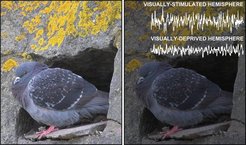Deep sleep in birds
Brain regions sleep more deeply when used more - also in birds
When we are asleep, those regions of our brain that were particularly active during wakefulness sleep more deeply. Researchers at the Max Planck Institute for Ornithology in Seewiesen, Germany and colleagues have demonstrated for the first time that this is also the case in birds. The researchers prevented pigeons from taking their afternoon nap by showing them David Attenborough’s nature documentary series The Life of Birds. An eye cap temporarily covered one eye during the movie session. During the following night, the researchers observed deeper sleep in the part of the brain neurologically connected to the stimulated eye compared with the same region in the other brain hemisphere. A non-visual region did not show such an asymmetry in sleep. (Proceedings of the Royal Society B, January 5, 2011)

Birds are the only animals outside of mammals whose sleep is also divided into a deep sleep phase, the so-called “Slow Wave Sleep” (SWS) and a dream phase, REM sleep (“Rapid Eye Movement Sleep”). During SWS sleep the brain generates strong electrical signals which are manifested as high-amplitude low-frequency waves in the electroencephalogram (EEG).
In mammals, the intensity of SWS increases and decreases as a function of prior time spent awake and asleep, respectively. This was now also shown for the first time in birds by researchers of the “Sleep and Flight”- Research Group at the Max Planck Institute of Ornithology in Seewiesen. Pigeons prevented from taking their normal afternoon naps slept more intensely at night. This suggests that birds respond to sleep deprivation in a manner similar to mammals, including us humans.
The local aspect of sleep
The new findings indicate that the similarity of mammalian and avian sleep seems to go even further. In both, sleep intensity depends on prior brain use during wakefulness. The researchers stimulated the visual processing region of one hemisphere of the pigeon brain by showing the birds David Attenborough’s nature documentary The Life of Birds while orientating one eye toward the film and capping the other. The videos were played continuously for eight hours during the day, and the researchers gently stimulated the birds to stay awake whenever they fell asleep. During the following night, the researchers measured sleep intensity in the visual processing regions of both hemispheres and compared them with other, non-visual regions.
As in mammals, the stimulated region showed more intense sleep than its counterpart in the other hemisphere. A non-visual region did not show this asymmetric effect in sleep intensity. “We observed mammal-like ‘local sleep’ in birds. It is therefore most likely that the main function of slow wave sleep is brain restoration", says John Lesku, first author of the study.












